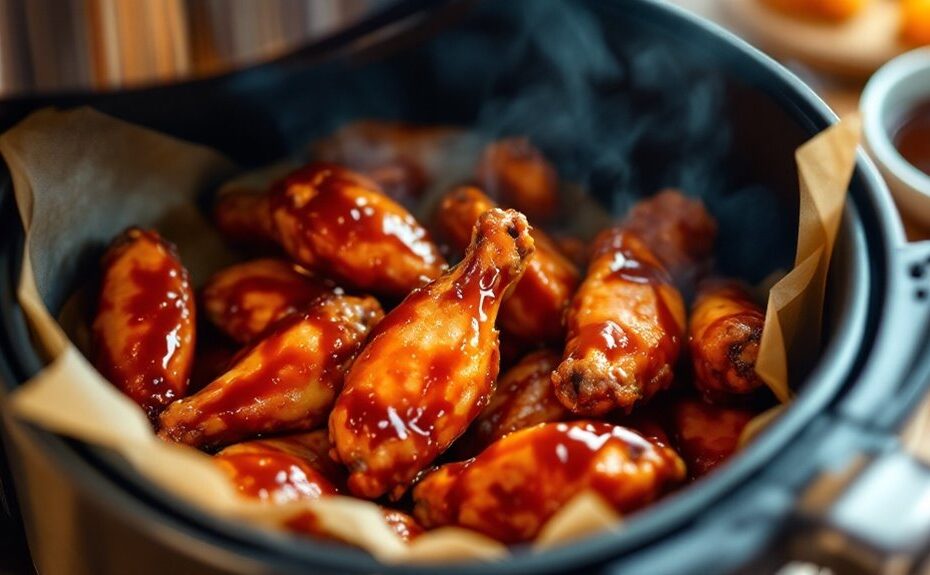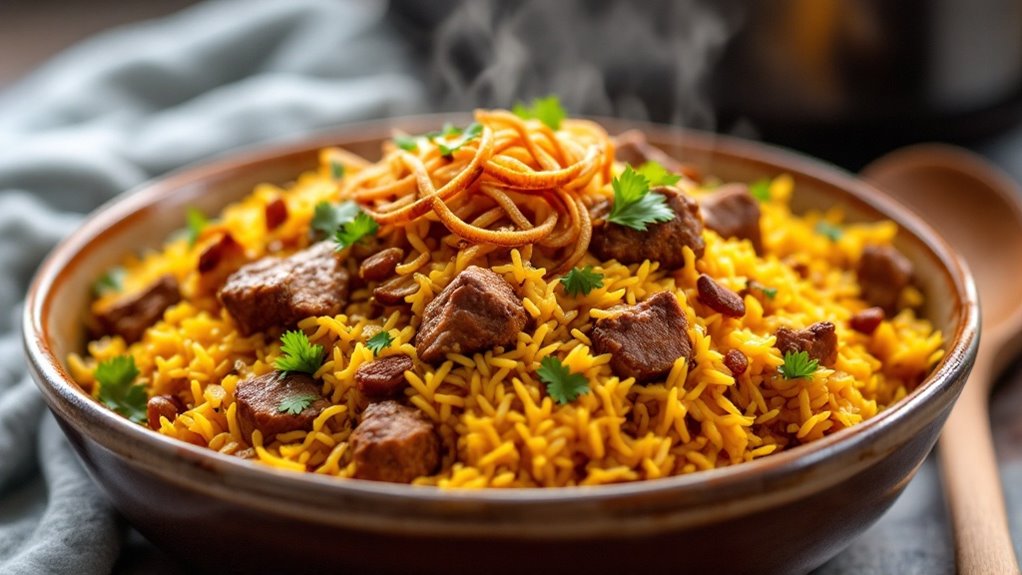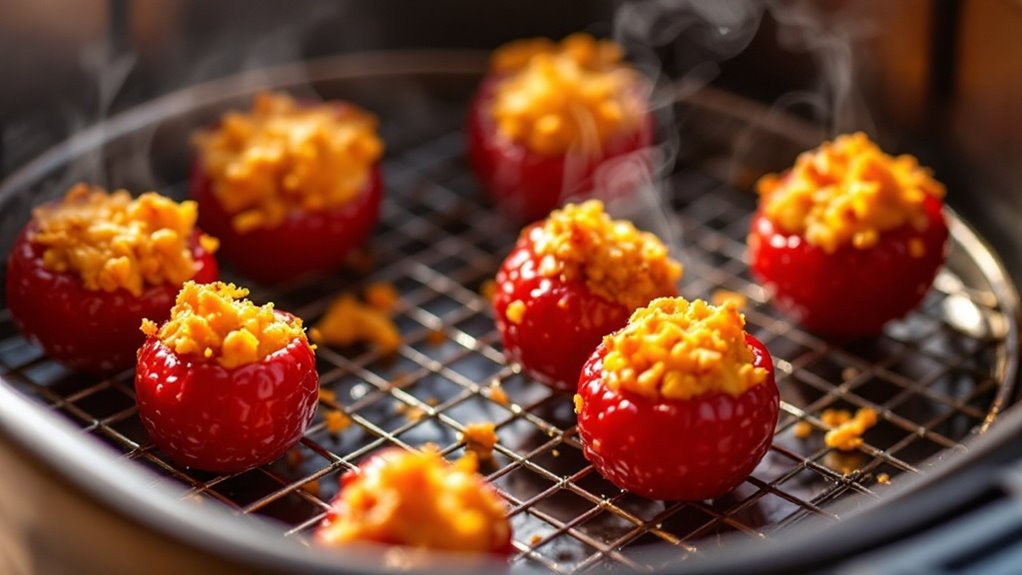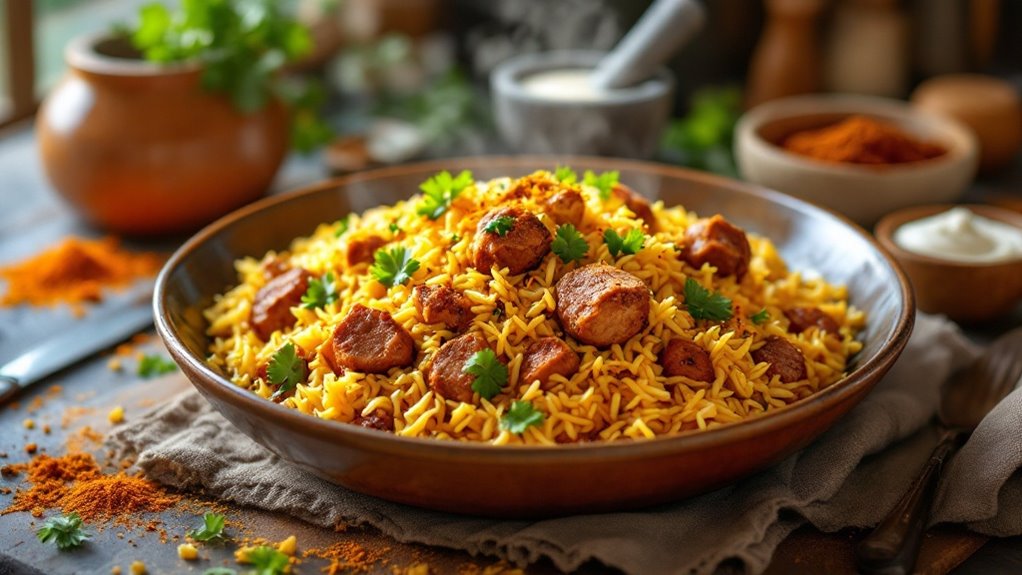Over 40% of air fryer users experiment with sauces, but many struggle to balance flavor and texture without creating a mess. You can cook with sauces in an air fryer, but it's not as simple as tossing everything in at once. Timing matters, and the type of sauce you use can make or break your dish. Thicker sauces behave differently than thinner ones, and prepping your food correctly is essential. If you've ever wondered how to achieve that perfect glaze without sacrificing crispiness, there's more to uncover about mastering saucy air fryer recipes.
Key Takeaways
- Yes, you can cook with sauces in an air fryer, but timing and thickness matter to prevent burning or uneven cooking.
- Apply thin sauces like teriyaki or soy during the last 2-3 minutes to avoid over-drying or scorching.
- Thicker sauces like barbecue or honey mustard should be added around the 5-minute mark to prevent burning.
- Pat food dry before air frying and reintroduce sauce later for even cooking and crispiness.
- Use parchment paper or silicone liners to minimize mess and protect the air fryer from sticky residue.
Choosing the Right Sauces for Air Frying
When selecting sauces for air frying, it's vital to assess their thickness and sugar levels, as these factors directly influence cooking outcomes. Thick sauces, like barbecue or teriyaki, can form a sticky coating but may burn if sugar content is high. Thin sauces, such as soy or vinegar-based marinades, spread evenly but require precise timing to avoid over-drying. Sauce compatibility with your air fryer's cooking method guarantees even browning and prevents mess. For flavor enhancement, choose sauces with balanced acidity and umami, as they complement the air fryer's crisp texture. Avoid overly sugary or oily sauces, as they can smoke or drip, impacting performance. Always test small batches to gauge how the sauce interacts with heat, securing ideal results without compromising your air fryer's functionality.
Prepping Food Before Adding Sauce
Before adding sauce to your food in the air fryer, it's essential to prep ingredients correctly to guarantee even cooking and the best texture. Start by patting proteins or vegetables dry with paper towels to remove excess moisture, securing crispiness. For sauce marination tips, marinate proteins for at least 30 minutes to allow flavors to penetrate, but avoid over-saturating to prevent steaming in the air fryer. Lightly coat vegetables or proteins with oil before air frying to enhance browning and prevent sticking. When applying sauces, use a brush or spoon for even distribution, securing no pooling occurs, which can lead to uneven cooking. Pre-cook denser ingredients partially if needed, as sauces can slow browning. Proper prep secures your sauce application techniques yield peak results.
Timing When to Add Sauces
To achieve ideal results when cooking with sauces in an air fryer, timing the application is critical. Apply thin, liquid-based sauces like teriyaki or barbecue during the last 2-3 minutes of cooking to prevent burning and maintain sauce consistency control. Thicker sauces, such as honey mustard or buffalo, can be added slightly earlier, around the 5-minute mark, as they're less prone to dripping or scorching. For breaded or coated foods, wait until the coating crisps before adding sauce to avoid sogginess. If you're marinating, pat the food dry before air frying to guarantee even cooking, then reintroduce sauce later. Always monitor the air fryer during the final minutes to adjust sauce application timing based on texture and doneness. Proper timing secures flavor infusion without compromising texture or creating a mess.
Avoiding Mess in the Air Fryer Basket
Applying sauces at the right time helps preserve texture, but managing their application also prevents a messy air fryer basket. To achieve sauce splatter prevention, brush or drizzle sauces lightly and evenly over food rather than pouring them directly. Thicker sauces work better as they're less likely to drip, while thin sauces can be reduced on the stovetop for better adherence. Minimizing residue buildup requires avoiding excessive sauce application, especially near the edges of the basket. Use a silicone brush for precise control and wipe off excess sauce from food surfaces before air frying. If you're cooking saucy items like wings, shake the basket halfway through to redistribute sauce and prevent pooling. These techniques guarantee cleaner cooking and easier cleanup without compromising flavor.
Using Parchment Paper or Liners
While parchment paper or liners can simplify cleanup, they also play a crucial role in managing airflow and preventing food from sticking in the air fryer. Parchment alternatives, like silicone liners, offer durability and reusability, making them eco-friendly options. When using liners, make sure they're perforated to maintain proper airflow, which is critical for even cooking. Liner benefits include reducing sauce drips onto the basket, minimizing mess, and protecting non-stick coatings. Always cut liners to fit your air fryer basket, avoiding overhang that could block vents or catch heat. For saucy dishes, liners prevent sauces from burning onto the basket, though you'll still need to monitor cooking to avoid oversaturation. Choose heat-resistant materials rated for air fryer use to guarantee safety and peak performance.
Adjusting Cooking Times for Saucy Dishes
When cooking saucy dishes in an air fryer, monitor the sauce thickness to determine if you need to reduce the initial cooking time by 2-3 minutes to prevent overcooking. Stir the dish midway through the cycle to guarantee even heat distribution and prevent sauce from pooling or burning. Adjust the final cooking time based on the consistency and doneness of your dish.
Monitor Sauce Thickness
Sauce thickness can greatly influence cooking times in an air fryer, so it's vital to monitor and adjust as needed. Thicker sauces with higher viscosity require longer cooking times to heat evenly, while thinner sauces may evaporate or splatter. To maintain ideal sauce consistency, check the viscosity control during cooking. If the sauce thickens too much, add a small amount of liquid (water, broth, or oil) to thin it. Conversely, if it's too thin, extend the cooking time slightly to reduce excess moisture. Use a silicone brush or spoon to redistribute the sauce periodically, guaranteeing even coating and preventing hotspots. Monitoring thickness guarantees your dish cooks uniformly and retains the desired texture without overcooking or drying out.
Reduce Initial Cooking Time
To guarantee saucy dishes cook evenly in an air fryer, you'll want to reduce the initial cooking time slightly compared to dry recipes. Sauces retain moisture, which accelerates cooking, so starting with a shorter time prevents overcooking. For example, if a recipe suggests 15 minutes for dry ingredients, begin with 10-12 minutes for saucy dishes. This adjustment secures the sauce marination process doesn't dry out or burn, preserving the flavor infusion. Use a lower temperature initially—around 325°F (163°C)—to let the sauce penetrate the ingredients without scorching. Check the dish's progress frequently, as air fryers vary in heat distribution. Reducing the initial cooking time also prevents the sauce from thickening too quickly, maintaining its desired consistency. This method balances texture and flavor, securing the best possible results.
Stir Midway for Evenness
Since air fryers rely on circulating hot air, stirring saucy dishes midway guarantees even cooking and prevents hot spots. Pause the cooking process halfway through and use a spatula or tongs to redistribute the sauce and ingredients. This maintains consistent sauce distribution and prevents edges from overcooking while the center remains underdone. For thicker sauces, fold the mixture gently to avoid splattering. For thinner sauces, stir more thoroughly to coat all surfaces evenly. Adjust stirring techniques based on the dish—delicate items like tofu or fish require a lighter touch, while heartier foods like chicken or vegetables can handle more vigorous mixing. Always check the internal temperature of proteins after stirring to confirm doneness. This step maintains your saucy dishes cook uniformly and retain ideal texture.
Cleaning Your Air Fryer After Saucy Recipes
After cooking saucy recipes, wipe down the air fryer's interior surfaces with a damp cloth to remove residue and prevent buildup. Remove accessories like the basket and tray, then wash them with warm, soapy water to eliminate sticky or hardened sauce. Make sure all components are completely dry before reassembling to maintain peak performance.
Wipe Down Interior Surfaces
Once you've finished cooking saucy recipes in your air fryer, it's essential to wipe down the interior surfaces promptly to prevent residue buildup. Start by unplugging the appliance and allowing it to cool slightly. Use a damp microfiber cloth or sponge to gently wipe the interior walls, heating element, and any exposed surfaces. Avoid abrasive materials that could scratch the non-stick coating. For stubborn sauce splatters, lightly dampen the cloth with warm, soapy water, but make sure no excess liquid drips into the heating components. Don't forget to wipe the basket and clean the tray thoroughly, as these areas often collect sticky residue. Dry all surfaces with a soft towel to prevent moisture accumulation, which can affect performance or cause odors over time.
Remove and Clean Accessories
To guarantee your air fryer remains in top condition, you'll need to remove and clean its accessories after cooking saucy dishes. Start by unplugging the appliance and letting it cool. Detach the basket, tray, and any removable racks. For accessory maintenance, soak these components in warm, soapy water for 10-15 minutes to loosen sticky residue. Use a non-abrasive sponge or brush to scrub away sauce remnants, paying attention to crevices. Rinse thoroughly and dry with a soft cloth to prevent water spots. Avoid harsh cleaning techniques like steel wool, which can damage non-stick coatings. If stubborn stains persist, apply a baking soda paste and gently scrub. Regular cleaning secures longevity and prevents cross-contamination during future cooking sessions.
Disclosure: As an Amazon Associate, I earn from qualifying purchases.



